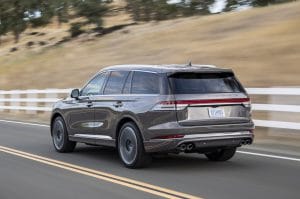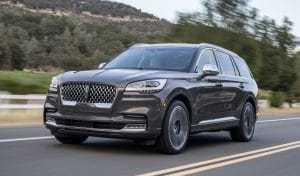Back in 2006, when Alan Mulally joined Ford Motor Co. as its new CEO he had a variety of tough decisions to make about the automaker’s broad brand portfolio. The former Boeing exec quickly decided to sell off European brands Aston Martin, Jaguar, Land Rover and Volvo and ordered the shutdown of Mercury, too.
Mulally came close to closing Lincoln, as well. Once a dominant brand in the U.S. luxury market, sales had largely dried up, especially if you didn’t count the aging Town Cars being diverted to fleet. But, in the end, the CEO was convinced not only to keep Lincoln alive but give it the money to develop a half-dozen new products. Models like the MKZ, MKX and MKC proved there might be life left in the brand – even if the alpha nameplates confused customers.
A second wave of new products is just beginning to roll out and, as Lincoln follows the lead of its sibling Blue Oval brand, it is shifting focus from passenger cars to high-end SUVs and CUVs — albeit not entirely. That notably includes the 2020 Lincoln Aviator just getting set to roll into dealer showrooms. This three-row midsize crossover is not just the brand’s newest model, but also the first offering to really nail down the “Quiet Flight” theme that Lincoln has adopted.
(Q&A: Lincoln’s New Chief Michael Sprague)
“The turning point will be this vehicle,” said Michael Sprague, new North American sales and marketing chief, during a media drive of the 2020 Lincoln Aviator. To see if he was on target we took several different versions of the new ute for a day-long drive through California’s Napa Valley wine country. Here’s a look at the gas-powered model.
Smaller than the brand’s flagship utility vehicle, the massive Navigator, the Aviator adopts an all-new platform that, ironically, was originally intended to underpin the Continental. It will also become the first Lincoln model to be offered with a plug-in hybrid drivetrain. Though officially designated a “midsize” model, Aviator manages to comfortably pack in three rows of seats and still have a reasonable amount of rear cargo space. The marque is hoping that this will help it attract young family buyers looking for a fair bit of luxury.

The 2020 Lincoln Aviator offers impressive power and capability combined with sleek elegance and intuitive technology.
The overall look of the new Aviator picks up on some classic Lincoln styling cues, such as the large, rectangular grille, without looking retro. That grille is now framed by slit-like headlamps. The work of well-regarded designer David Woodhouse – who was recently poached by Nissan – the Aviator has a nicely sculpted appearance, with a sharp crease running the length of the hood and subtle scalloping along the doors. From the rear it adopts a subtle, coupe-like dip to the roofline, albeit far less aggressive than some competing models – which helps retain good headroom for passengers in all three rows.
Step inside and you’ll see where the 2020 Lincoln Aviator really shines, however, without question the most elegant modern execution the brand has delivered. We can only lament that the slow-selling Continental sedan hadn’t offered what Woodhouse’s team accomplished here.
For those who want the most luxurious execution, there is the Black Label edition of the new Aviator. But even the “base” model’s cabin offers a lavish mix of leather, metals and woods, all pulled together seamlessly. The horizontal layout of the instrument panel is a highpoint. Lincoln has made good use of the latest Sync infotainment system, with its big touchscreen mounted atop the center stack. It helps eliminate a number of knobs and buttons but designers wisely left those you’d access most, such as climate controls and a volume knob.
The Sync system is just one of many new high-tech features on the 2020 Aviator. There is an assortment of advanced safety systems, including forward collision warning and blind-spot detection. And one of the optional feature packages includes Lincoln’s new phone-as-key technology. It allows you to not only lock and unlock, but start and run, the Aviator without carrying a conventional key.
Another favorite features is the Revel Ultima 3D audio package. This 28-speaker system seemingly puts you right onto the stage as you’re listening to your favorite tunes.
It’s an appropriate part of the Quiet Flight package. Turn your music down for a minute and you’ll notice a lack of wind and road noise, thanks to the extensive use of sound-deadening insulation, as well as active noise-cancelling technology.
(The People Have Spoken: Lincoln, Ram and Nissan Take Top Honors)
It’s not a mausoleum, however. You’ll still hear a reassuring roar from under the hood when you slam down the throttle on the Aviator’s 3.0-liter Twin-Turbo V-6 which makes a robust 400 horsepower and 415 pound-feet of torque.
The engine is mated to a new 10-speed automatic transmission that shifts almost imperceptibly under most driving situations. The Aviator is available in both rear-wheel-drive and all-wheel-drive configurations. Despite its size, the RWD package manages to deliver 18 mpg in the city, 26 on the highway and 21 in the EPA’s combined rating. The AWD configuration deliver 17/24/20.
While the “architecture” underpinning the Aviator never wound up being used by the Lincoln Continental, it is shared with the latest-generation Ford Explorer. But, unlike in years past, company engineers made sure the up-market brand’s SUV wasn’t just a gussied-up clone. There’s been significant revisions made to the Lincoln’s suspension, in particular, to help deliver a ride that, we found, was an uncanny blend of comfort and handling.
It helped that we were riding a well-equipped model featuring the Air Glide suspension, air bladders at each of the Aviator’s four corners replacing conventional springs, with a variety of sensors all but instantaneously adapting the stiffness of each corner to account for road conditions. The same windshield-mounted camera used for various advanced driver assistance systems, or ADAS, also monitors the road as much as 50 feet ahead so the adaptive suspension system can adjust proactively, rather than reactively when, say, your wheel starts to fall into a pothole.
The Aviator lets you bring all these features together with the optional Dynamic Handling Package. We put it to the test as we went on our way through wine country and the mountainous country surrounding the Napa Valley. Under aggressive driving, Lincoln’s new three-row model seems far smaller and more nimble than its size and mass – which can approach 4,900 pounds, depending upon options – would suggest.
The crossover-utility market is growing rapidly, both in sales and in the range of offerings. The 2020 Aviator will go up against such competitors as the Acura MDX, Audi A7, Infiniti QX60 and Mercedes-Benz GLE – as well as rival Cadillac’s also-new XT6.
At $52,195, Lincoln’s three-row model comes in about $1,500 below that Caddy, though the entry version of the Acura crossover starts at $44,400 before delivery fees. The all but fully equipped Aviator Black Label jumps way up to $78,790.
Lincoln’s entry might not be the pick for those who want the sportiest ride and handling. The Caddy, which we recently reviewed, is more aggressive, with a bit more precise road feel. But the Lincoln stands out as a solid bet in virtually every category you can imagine. It is stylish, roomy, quiet and comfortable. It has great road manners and a reasonably fuel-efficient powertrain.
(Lincoln Corsair: A Small SUV with a Big Role to Play)
If the 2020 Aviator is an example of what the long-struggling brand means by “Quiet Flight,” well, Lincoln may finally be ready to take off.



